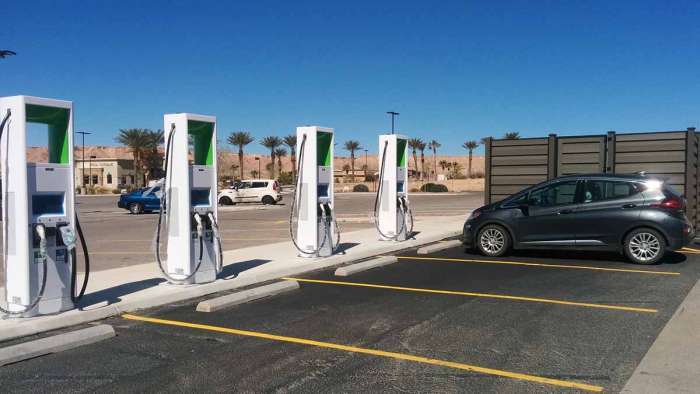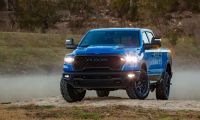I’ve read an increasing number of news articles and stories that either openly question GM’s commitment to building electric vehicles or imply that GM isn’t actually serious about following through on CEO Mary Barra’s plan presented to Barclays in late 2017. In both cases, I think these stories are missing the mark because they are attempting to assign emotional motivations to what are quite clearly pragmatic business decisions.
Based on what I’ve observed from GM’s actions and the comments and statements of various executives, they are certainly committed to a fully electric future; however, they are also not ready just yet. GM is clearly waiting on two breakthroughs before it plunges full-force into electric vehicle production, marketing, and sales. Those two breakthroughs are electric vehicle viability and profitability.
While I don’t always agree with GM’s electric vehicle strategies, I have no reason to doubt their commitment to transitioning to all-electric vehicles after they move past those two perceived barriers. To me, the more significant point is that GM – one of the largest automakers in the world – now believes that they will soon be able to build viable electric vehicles profitably.
In this story, I will explain exactly what I think electric vehicle viability and profitability look like to GM, and how soon we can actually expect them to start mass producing electric vehicles.
Significance of the Chevrolet Bolt EV
Before I start, I do want to call attention to the Chevy Bolt EV, which I think is the principal reason we’ve seen GM start a very rapid shift to electrification across their entire fleet, stating that they will have 20 electric vehicles available by 2023. The Bolt EV also enables us to more accurately define what GM considers “profitable” and “viable” as it relates to electric vehicles.
As someone who has owned and followed GM electric vehicle products since 2012, I noticed a marked change in GM’s tone toward electric vehicles in early to mid-2016. While that is technically before the Chevy Bolt EV was released, it was after GM had more or less finalized the design. I had personally seen a Bolt EV driving around in full zebra camo in late 2015, and I was able to drive next to it on the freeway for several miles before it pulled off at the Camarillo Outlets (presumably to charge at the EVgo DC fast charger).

Even before GM unveiled the Chevy Bolt EV to the press or published the official EPA range numbers, they knew they had a winner. My impression was that they left their engineers alone to build the Bolt EV, and the results surprised even their executive team. Chevrolet proudly invited members of the press to drive the Bolt EV 229 miles from Monterey to Santa Barbara on a single battery charge (a feat that many in the EV world attempted to dismiss as nothing more than a publicity stunt, though the Bolt EV’s EPA rating and real-world range proved otherwise).

When it came time for deliveries, GM intended to do a slow roll out of the Chevy Bolt EV, focusing primarily on deliveries to California. Most states wouldn’t have access to the car until after August of 2017, about nine full months after the first full load of Bolt EVs was delivered to California. However, the response by consumers actually forced GM to change their policies because the Bolt EV appeared to be every bit as popular outside of California. A number of people in other states ordered cars in California and either had them delivered or drove them back to their home states, so GM put a moratorium on California Chevy dealerships selling to out-of-state buyers.
By November of 2017, GM CEO Mary Barra was delivering a presentation to Barclays, laying out GM’s plan for a fully electrified future with “Zero Crash, Zero Emissions, Zero Congestion.” The Bolt EV was front and center, and it was the first step in that path.
Chevy Bolt EV Profitability
In numerous stories and interviews, GM representatives have emphasized that the Chevy Bolt EV is not profitable. However, what GM saw in the Chevy Bolt EV was a pathway to profitability for electric vehicles.

Early on, news leaked that GM was only paying $145 per kWh of battery capacity for LG battery cells, which was more than 30% less than many other EV automakers were paying at the time. Still, it meant that the cost of the Chevy Bolt EV’s battery cells alone was $8,700 (nearly a quarter of its $36,620 MSRP).In the five years following the Bolt EV’s release, GM projected battery costs to continue dropping. By 2020, battery prices were anticipated to drop to $120 per kWh, and then again to $100 per kWh by 2023. That would result in another 30% reduction in battery cell costs, and the cost of the Chevy Bolt EV’s battery cells would be less than $6,000.
According to a separate UBS report, each 2017 Chevy Bolt EV cost GM about $28,700 in materials and labor to produce. Compared to the MSRP, that production cost leaves very little in the way of margins. Per that same report, GM would eventually be able to make the Bolt EV profitably if they were able to produce over 200,000 units. Without those economies of scale, however, the Bolt EV wouldn’t be profitable when sold at MSRP without some other factor.
Currently, that factor is the ZEV credits, which enable GM to sell the Chevy Bolt EV profitably in a number of states that have adopted the CARB model. The Chevy Bolt EV qualified for 3.9 ZEV credits, and at $5,000 per ZEV credit, GM was more than able to make up their losses selling the Bolt EV in CARB states.
However, due to constantly shifting regulations and requirements, those ZEV credits cannot be counted on long term. In order for GM to consider an electric vehicle to be profitable, that vehicle’s margins cannot be based on an outside regulatory incentive. While GM doesn’t need to reduce the Chevy Bolt EV’s production costs by the entire $19,500 they receive in ZEV credits, they do reduce production costs enough so that the Bolt EV (and other GM electric products) can stand on their own without government incentives.

The $3,000 reduction in costs per battery that GM foresees will offset some of that need for ZEV credits, but the rest is likely to come from improving delivery chains, streamlining production, and improving economies of scale. In 2018, GM worked with LG to build a new electronic components plant in Hazel Park, Michigan, reducing the cost and time to deliver electronic components to the Orion Assembly plant. In March 2019, GM announced a $300 million investment in the Orion Assembly plant to add an additional electric vehicle to be built alongside the Chevy Bolt EV. And in December 2019, GM announced a $2.3 billion joint venture with LG to build a battery manufacturing facility in Lordstown, Ohio that would support the manufacturing of hundreds of thousands of electric vehicles per year.
Chevy Bolt EV Viability
In terms of viability, the Chevrolet Bolt EV also provides some insights into what GM considers a viable electric vehicle. Prior to the Chevy Bolt EV’s EPA rating being released, some GM employees and representatives had leaked that the Bolt EV’s range would be over “200 miles.” This humility is rare among automakers, and it actually led many people in the EV world to believe that the Chevy Bolt EV would see an EPA range rating of just 160 to 180 miles. I was actually laughed at in the GM-Volt forums for even including an option for over 230 miles of EPA range when I set up a poll for members to guess the upcoming 2017 Chevy Bolt EV’s range, so it was quite a shock when the Bolt EV’s published EPA range was 238 miles.

As a Chevy Bolt EV owner who has driven a lot of hard miles, however, I can see exactly where GM was coming from when they referred to the Bolt EV as a “200-mile EV.” With gentle driving around town, it’s easy to get close to 300 miles out of a single Chevy Bolt EV battery charge, but when winter weather sets in or you take it out on a long freeway drive, the Bolt EV’s maximum range drops quickly. When I go on my long, freeway speed drives, I no longer consider my 2017 Chevy Bolt EV a 238-mile electric vehicle. I plan to see no more than 200 miles out of a full battery charge.
For the average American driver, they can expect to see 20% to 40% less than the EPA rated range in an electric vehicle when driving at freeway speeds or during winter. This is counter intuitive for the average automotive consumer because the internal combustion vehicles they are accustomed to operate the opposite way. Essentially, a gas powered car will get worse mileage in the city and better mileage on long freeway drives, and GM’s hypercritical range assessments of their own electric vehicles might align better with customer expectations than the EPA’s rating system.
More importantly, that conservative approach to range rating provides insight into what GM considers a “viable” electric vehicle. Throughout Mary Barra’s presentation to Barclays, she refers to “300 miles” as the new standard for electric vehicles, and even GM’s work with Envia (a failed battery producer) was built around gaining access to batteries that would enable a “300 mile” electric vehicle. If GM is being consistent with their internal language, their expectation for viable electric vehicle is that they are capable of 300 miles of range per battery charge even at freeway speeds in a variety of vehicle formats.
I also must emphasize that last point about formats. Most American consumers are, at this point, moving away from small cars and toward crossovers and SUVs. Regardless of the reasoning, this change in consumer taste means that it is not possible to rely solely on efficient car designs in order to achieve 300 miles of range. Tesla has proven that achieving close to 300 miles of range at freeway speeds is possible in an electric vehicle; however, it’s only possible when relying on a small, sedan format (one of the most aerodynamic shapes for a vehicle). GM, on the other hand, is emphasizing these crossovers and larger SUVs, so 300 miles of range will be a bit more difficult to achieve.

In fact, a large segment of GM’s business is focused on building trucks, and in a recent article, GM President Mark Reuss outlined three problems that need to be overcome in order for electric trucks to be viable. The key problem that Reuss identified was range, which demonstrates how keenly aware GM is that 300 miles of range in a truck is extremely hard to achieve. The other problems Reuss identified were price, which ties back to what I described earlier about GM’s waiting for electric vehicle profitability (they have to be able to sell these vehicles for a profit at a reasonable price) and infrastructure.
That last point also indicates a shift in GM’s perception about the importance of public charging infrastructure as an aspect of electric vehicle viability. This is further supported by GM’s announcement in May 2019 that they were partnering with Bechtel (one of the nation’s largest construction firms) to build a nationwide infrastructure of charging stations. GM would provide data based on electric vehicle driving behaviors, and Bechtel would provide engineering and construction support. While there hasn’t been a significant update, GM was seeking investors to help fund the network.

Ultimately, all of these issues of electric vehicle viability appear to hinge around battery technology, and in the same Barclays presentation where Mary Barra spoke about battery cost reductions, she also referenced a new, modular battery technology that would support longer ranges and faster charging speeds.
Conclusion
It might appear to some that GM has been dragging their feet in terms of building, developing, and selling electric vehicles; however, it is more likely that GM is strategically investing in production facilities and partnerships that will enable them to profitably build compelling electric vehicles when the technology required to do so is available. GM clearly doesn’t consider electric vehicles with less than 300 miles of real-world range to be viable as mainstream offerings, and those vehicles will not be profitable outside of regulatory incentives until battery production prices reach $100 per kWh or less.
While it is clear that GM isn’t ready to move fully into electrification at this point, their investments and partnerships indicate when we can expect that to happen. Those developments also align with GM’s announcement that they will have 20 new electric offerings by 2023, a point when both electric vehicle profitability and viability will likely be achieved.
About The Author
Eric Way focuses on reporting expert opinion on GM brand electric vehicles at Torque News. Eric is also an instructional designer and technical writer with more than 15 years of writing experience. He also hosts the News Coulomb video blog, which focuses on electric vehicles, charging infrastructure, and renewable energy. Eric is an active member of the EV Advocates of Ventura County, a volunteer organization focused on increasing the widespread adoption of electric vehicles. You can follow Eric on News Coulomb Youtube, on Facebook at @NewsCoulomb as well as on Twitter at @eway1978.













Comments
Great story Eric. Often
Permalink
Great story Eric. Often overlooked by many EV advocates is that every public company has a legal obligation to make decisions based on shareholder value and profitability. GM has produced the top-selling affordable EV in America and has had the most EV models among all automakers. But boy, does their "All-electric future" seem far off given the current product mix and most recent new vehicle intros. All of which had V8 engines.
> GM has produced the top
Permalink
In reply to Great story Eric. Often by John Goreham
> GM has produced the top-selling affordable EV in America and has had the most EV models among all automakers
This is false. The Nissan Leaf has sold 141,907 way more than the Bolt at only 35,683. GM only sells 1 EV. Tesla sells 3 models and will soon begin production on the Model Y. If you are including plug-in models then BMW sells more with the i3, X5, 330e, 530e, 740e, i8.
"Tesla has proven that
Permalink
"Tesla has proven that achieving close to 300 miles of range at freeway speeds is possible in an electric vehicle; however, it’s only possible when relying on a small, sedan format (one of the most aerodynamic shapes for a vehicle)."
Current Model X Long Range is rated at 328 miles EPA combined, 317 miles highway. ABRP estimates actual range at 70 mph is closer to 270 miles, which seems close enough to 300.
ABRP guesses 260 miles (highway 70 mph) for Mustang Mach-E RWD, 250 miles for Tesla Model Y LR RWD. These are obviously unreleased vehicles and the alpha models are based solely on manufacturer claims.
300 miles highway range in larger vehicles will require commitment to an aerodynamic design along with designing larger battery packs: 130 kWh and higher. Tesla is leading the "big battery" push, with the Model S 85 in 2012, the S / X 100D in 2016 and Cybertruck, Roadster coming next year.
Put a 130 kWh battery in an
Permalink
In reply to "Tesla has proven that by protomech (not verified)
Put a 130 kWh battery in an EV and you might as well be driving a standard Prius Hybrid, since the lifecycle CO2 emissions is about the same for most areas in the U.S.
If a standard Prius is an
Permalink
In reply to Put a 130 kWh battery in an by Timothy Parker (not verified)
If a standard Prius is an option, it probably is a better choice. Even in regions with low CO2 electricity, an inefficient EV like Audi e-tron is only marginally more efficient than the Prius, at 80 mpg CO2 equivalent (and much worse in high-carbon regions, ie 35-40 mpg equivalent in Appalachia). A 130 kWh battery pack will only add even more weight - 6000 pound vehicles are not a positive direction, for vehicle safety, road wear, etc.
HOWEVER. The trend in the US is increasingly towards larger vehicles - most people decide what type / size of vehicle to buy and then cross-shop within that class. It is better to have EV options within the class than not - an electric half-ton pickup displaces far more gas consumption than choosing an electric Ioniq vs a standard Prius.
And while larger batteries will produce more CO2 initially - in most cases, comparing against gas vehicles in the same class - the manufacturing CO2 cost is break even within 2-3 years. See UCS cradle to grave comparisons, etc.
I think everyone understands
Permalink
I think everyone understands that GM's first priority is always to their bottom line and their shareholders. However, waiting around for the perfectly designed and marketable EV to appear before making any real effort to sell them is a pitiful excuse for not moving forward with EVs. That's not how GM started selling ICE cars 100 years ago. What if GM 100 years ago decided they weren't going to sell gasoline powered cars until they could put air conditioning in them and still make a profit. It didn't make sense then and it doesn't make sense now. GM will never build a profitable EV by selling them one or two at a time each day. And that's the point isn't it? They don't want to build them to begin with. Otherwise why would GM be working so hard to get emissions standards relaxed?
If GM wants to make money selling EVs they need to scale up production and sales. Especially the sales part. Make the effort to sell EVs or shut the hell up. If you want to see how truly committed GM is to a electric vehicle future, walk onto any GM dealer lot. Better yet, visit three or four dealers. Ask them to let you see and test drive a Bolt. Ask them to take you around back and show you how the electric charger works.
I've been driving a Nissan Leaf since 2011. I have a retired friend who I run around town with pretty regularly. After years of excursions in my Leaf, he finally got curious enough to look at EVs. He's a Korean war vet and will never (knowingly) own a foreign car. I don't have the heart to tell him the Buick his wife drives was probably built in China. Anyway, one Saturday we drove around to the local Ford and GM dealers. He's been driving Ford pickups since he got back from the war. Our experience was laughably pathetic and embarrassing for the dealerships.
One GM dealer told us they only selll "real cars". Another GM dealer had a Bolt, but it hadn't been charged "since I don't know when". Yet another GM dealer was happy to tell us they carry the Bolt and could order one, but they sold the last one they had a few months ago. When we asked them to show us how the charger worked, they spent 30 minutes trying to find someone who knew. Finally the very nice service department manager took time from his busy day to come out and walk my friend through the very simple process of charging. Visits to two Ford dealers revealed they had no EVs or interest in selling them.
GM had journalists drive from
Permalink
GM had journalists drive from Monterey to Santa Barbara because the Bolt is not as efficient at high speeds. Most of the route they had journalists take follow highway 1 where traffic and curves limit speeds to 55mph or less. Also the Bolt doesn't have traffic aware cruise control and they didn't want journalists to be testing cruise in heavy traffic situations.
The battery, motors, controllers and infotainment in a Bolt were outsourced to LG which made it difficult for GM to add mobileye's supercruise.
Tesla has proven that EVs can go 300 miles, even SUVs. Ford has unveiled an electric SUV that can go 300 miles. GM had better get working or they will get left in the dust by the Cybertruck.
Good article. My comments: 1)
Permalink
Good article. My comments: 1) On a road trip in moderate temperatures I routinely get over 270 miles on a full charge. I do tend to travel at 55 though. And, if I recharged to only 80% that would reduce the range to about 220 for that charge, and less practical range to leave a buffer.. 2) For trucks needing range, that is where a PHEV would work well. Many daily uses could be in EV mode while those longer, perhaps more demanding trips would be supplemented with the ICE. Too bad GM has backed away from hybrid drivetrains. GM shouldn't have used their experience with the Volt to influence their thinking. The Volt was a compact, perhaps subcompact, sedan, a format that most don't want. Put the Volt drivetrain in a crossover, SUV or truck and it's a winner, and achieves most of the environmental benefits of a full EV. 3) I have a hard time believing that their partnership with Bechtel will produce anything at all. For the foreseeable future, we're really dependent on EA to come through, and so far so good.
My efforts to test drive and
Permalink
My efforts to test drive and get quotes on a Bolt in October were unpleasant. One salesperson said "I hate those cars" and went on to explain how glad he was they were sold out and how the dealership didn't make money on them but were forced to sell a certain number to satisfy a tiered quota system. So I test drove a used Spark EV instead. But it is really hard to buy a BEV from a dealer with no fast charger - how are they going to diagnose, fix, and test fast charging problems?
So why is GM's next BEV going to be sold in China only? Looks like a larger crossover; Bolt seems a bit narrow to me.
As the charging infrastructure improves, range becomes less important and charging speed in kW dominates. This was a weakness of the otherwise revolutionary Bolt (thanks, Daewoo engineers!). Yet range obsession continues to push up weight and price of new BEVs. Because of the per-minute pricing model for most major charging networks, I find myself leaving a charger @ 60% SOC when the rate tapers (2019 Leaf), so the top 40% of battery rarely gets used but I carry around that weight anyway. When does the Bolt drop it's charging speed?
I am glad GM has changed their direction on public charging networks - can't wait to charge at a Bechtel-GM station.
The biggest problem with the
Permalink
The biggest problem with the major automakers in creating competitive EVs is that 100% of their profit comes from fossil fueled cars. GM doesn't have to build and electric Silverado that competes in all ways to their top work trucks. All of the automakers used to have mini-pickups 20 years ago, But they dropped them because of the higher profit margin of larger trucks. People always lose sight of the fact that fossil fueled vehicles still make up 97% of new vehicle sales. Even though EV enthusiasts like to proclaim that fossil fuel vehicles are on the way out, the truth is that the big automakers are simply dragging their feet, telling the world (and the press) that EVs are the future, but then cutting the production of almost all of their economy cars and hybrid models. The thing that will get them on the right track with EV production isn't some magic technology that enables them to build slightly cheaper BEVs, it is simply superior competition taking away their potential profits. Tesla's Model 3, and soon Model Y, and Ford's Mach-E clearly show that there is a strong market for BEVs. The Bolt (like the Volt before it) showed that GM can engineer and build great EVs, but they did a terrible job in backing them through marketing and dealer support, Then again marketing and dealerships are solely focused on short term profits. And in that way the American automakers gave away the small car market for decades to the Japanese and Europeans, and set up future generations to value imported cars more. GM said that the Camaro wasn't profitable, and they killed it off and gave away the market to the Mustang, Challenger, and various imports until they realized that there was profit in making a truly competitive version of the Camaro. So I see the fossil fueled automakers of today to slowly move to electrification over several years, not because it is cool, not because it is green and they love the earth, but because their EV-only competition is taking away profits by building superior BEVs, and those EV-only automakers are not held back by conflicts of short term profits made by fossil fueled vehicles.
As long as we have drifted
Permalink
As long as we have drifted into Tesla land, my prediction is that Tesla will have to change their business model if they don't want to become a niche EV maker. Selling by website with no showrooms or local dealers is not what will appeal to most car buyers. Sure, techno-enthusiasts might be ok, but not most people. I never really considered buying a Tesla, and one reason is that I was not going to travel to SoCal to actually sit in one. Looking at internet pictures, reading test reports, watching YouTube videos and doing an online "build" is no substitute for a live evaluation. While going through the process this year, I visited multiple showrooms, went on many test drives, and found great differences between test reports and the live experience. Tesla's sales model will not cut it for most people.